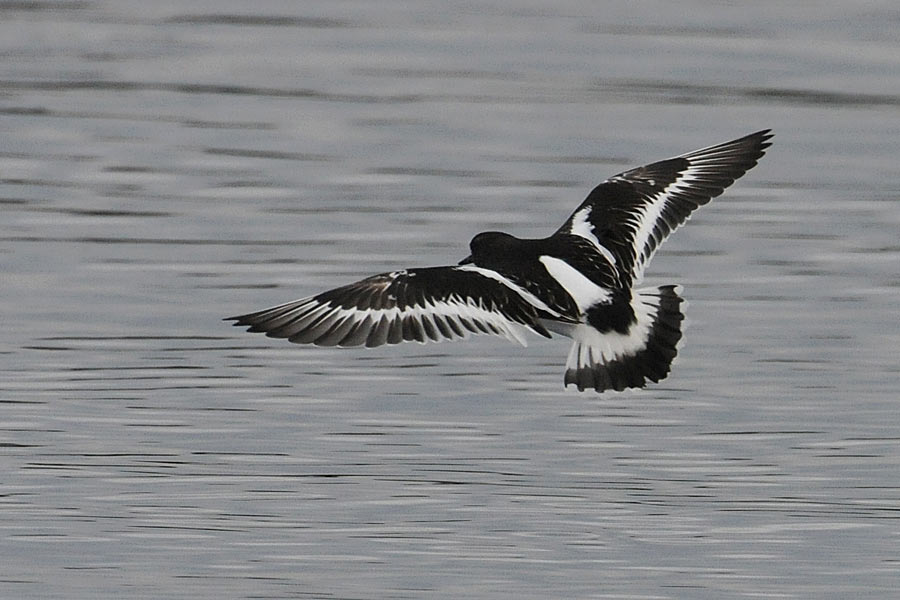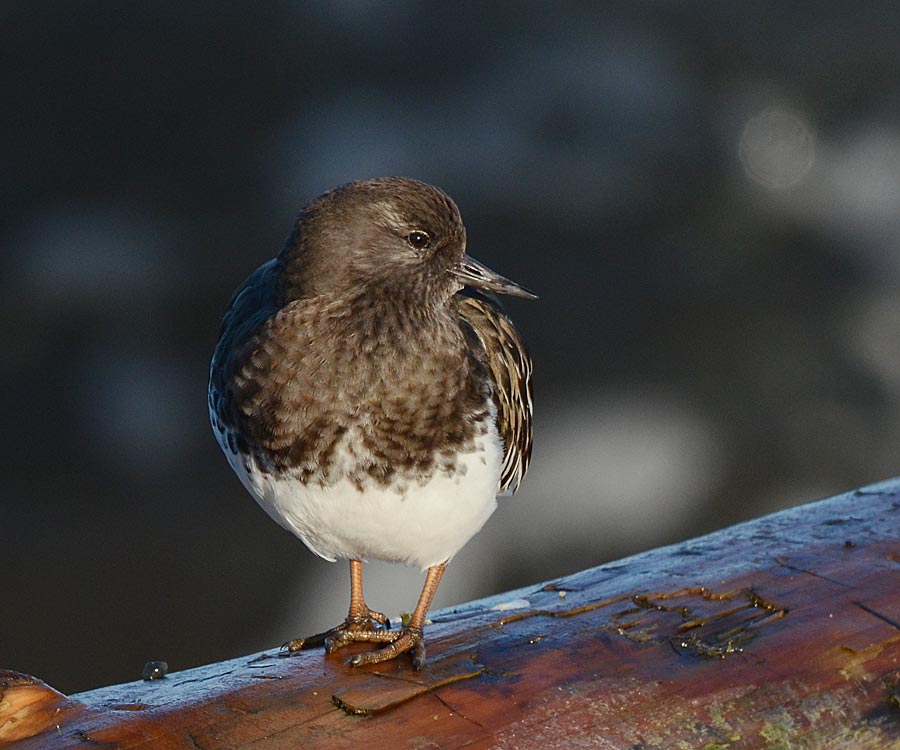Black turnstone • Arenaria melanocephala

Black turnstones in winter plumage. Photos by Mike Yip.
|
Identification
This stocky shorebird has short reddish-brown legs and a fairly rounded, plump body. Its bill is short, dark, and slightly upturned. Its winter plumage is dark grey above and white below. In breeding plumage the dark grey becomes black; there is also a white eyebrow and white lore spots (in front of each eye), as well as white spotting on the sides of its neck and breast. When in flight observers will be able to see a thick black band at the end of the bird's relatively short white tail, as well as two bold white wing stripes and a white patch on its lower back. Juvenile plumage is similar to that of adults in winter, but more brownish-grey and with a brown tail tip.
Habitat & Range
The black turnstone winters on rocky coastlines from southern Alaska to Baja California. Its slate grey winter colouring allows it to blend in well with the dark rocks, particularly when sitting still. In summer it nests on coastal tundra in northern Alaska.
Similar Species
The surfbird (Calidris virgata) is also dark grey above and white below in winter, when it too is found on rocky coastal shorelines. It tends to be not quite as dark grey as the black turnstone, however, and there are some dark arrow-shaped spots on its white undersides. Its bill is bicoloured, with a yellow base and black tip, and its legs are more yellow than reddish-brown. The rock sandpiper (Calidris ptilocnemis) has a long, slightly downcurved bill with a yellow base, and its winter plumage is patterned grey above with some grey spotting on the breast.
Intriguing Info
This bird gets its name from its habit of turning over stones while foraging for barnacles, limpets, insects, and other intertidal invertebrates. It gets aggressive towards predatory birds such as jaegers and gulls when nesting, and will fly over 100 m away from its territory to chase away aggressors.
This stocky shorebird has short reddish-brown legs and a fairly rounded, plump body. Its bill is short, dark, and slightly upturned. Its winter plumage is dark grey above and white below. In breeding plumage the dark grey becomes black; there is also a white eyebrow and white lore spots (in front of each eye), as well as white spotting on the sides of its neck and breast. When in flight observers will be able to see a thick black band at the end of the bird's relatively short white tail, as well as two bold white wing stripes and a white patch on its lower back. Juvenile plumage is similar to that of adults in winter, but more brownish-grey and with a brown tail tip.
Habitat & Range
The black turnstone winters on rocky coastlines from southern Alaska to Baja California. Its slate grey winter colouring allows it to blend in well with the dark rocks, particularly when sitting still. In summer it nests on coastal tundra in northern Alaska.
Similar Species
The surfbird (Calidris virgata) is also dark grey above and white below in winter, when it too is found on rocky coastal shorelines. It tends to be not quite as dark grey as the black turnstone, however, and there are some dark arrow-shaped spots on its white undersides. Its bill is bicoloured, with a yellow base and black tip, and its legs are more yellow than reddish-brown. The rock sandpiper (Calidris ptilocnemis) has a long, slightly downcurved bill with a yellow base, and its winter plumage is patterned grey above with some grey spotting on the breast.
Intriguing Info
This bird gets its name from its habit of turning over stones while foraging for barnacles, limpets, insects, and other intertidal invertebrates. It gets aggressive towards predatory birds such as jaegers and gulls when nesting, and will fly over 100 m away from its territory to chase away aggressors.
References
Black turnstone. The Birds of North America Online (A. Poole, Ed.). Ithaca: Cornell Lab of Ornithology; Retrieved from the Birds of North America Online. Accessed 31/05/2016.
Black turnstone Arenaria melanocephala. Audubon Birds. National Audubon Society. Accessed 31/05/2016.
Dunn, J. L. and Alderfer, J. (Eds.). (2011). National Geographic Field Guide to the Birds of North America. (6th Ed.). Washington, D.C.: National Geographic Society. Pp. 188-189.
Authors and editors of page
Kelly Fretwell (2016).
Black turnstone. The Birds of North America Online (A. Poole, Ed.). Ithaca: Cornell Lab of Ornithology; Retrieved from the Birds of North America Online. Accessed 31/05/2016.
Black turnstone Arenaria melanocephala. Audubon Birds. National Audubon Society. Accessed 31/05/2016.
Dunn, J. L. and Alderfer, J. (Eds.). (2011). National Geographic Field Guide to the Birds of North America. (6th Ed.). Washington, D.C.: National Geographic Society. Pp. 188-189.
Authors and editors of page
Kelly Fretwell (2016).




